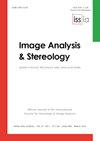AUTOMATIC LUNG NODULE DETECTION BASED ON STATISTICAL REGION MERGING AND SUPPORT VECTOR MACHINES
IF 1
4区 计算机科学
Q4 IMAGING SCIENCE & PHOTOGRAPHIC TECHNOLOGY
引用次数: 15
Abstract
Lung cancer is one of the most common diseases in the world that can be treated if the lung nodules are detected in their early stages of growth. This study develops a new framework for computer-aided detection of pulmonary nodules thorough a fully-automatic analysis of Computed Tomography (CT) images. In the present work, the multi-layer CT data is fed into a pre-processing step that exploits an adaptive diffusion-based smoothing algorithm in which the parameters are automatically tuned using an adaptation technique. After multiple levels of morphological filtering, the Regions of Interest (ROIs) are extracted from the smoothed images. The Statistical Region Merging (SRM) algorithm is applied to the ROIs in order to segment each layer of the CT data. Extracted segments in consecutive layers are then analyzed in such a way that if they intersect at more than a predefined number of pixels, they are labeled with a similar index. The boundaries of the segments in adjacent layers which have the same indices are then connected together to form three-dimensional objects as the nodule candidates. After extracting four spectral, one morphological, and one textural feature from all candidates, they are finally classified into nodules and non-nodules using the Support Vector Machine (SVM) classifier. The proposed framework has been applied to two sets of lung CT images and its performance has been compared to that of nine other competing state-of-the-art methods. The considerable efficiency of the proposed approach has been proved quantitatively and validated by clinical experts as well.基于统计区域合并和支持向量机的肺结节自动检测
肺癌是世界上最常见的疾病之一,如果在其生长的早期阶段发现肺结节,就可以治疗。本研究通过计算机断层扫描(CT)图像的全自动分析,开发了一种新的肺结节计算机辅助检测框架。在目前的工作中,多层CT数据被送入预处理步骤,该步骤利用自适应扩散平滑算法,其中参数使用自适应技术自动调整。经过多级形态学滤波,从平滑后的图像中提取感兴趣区域(roi)。将统计区域合并(SRM)算法应用于roi,对CT数据的每一层进行分割。然后对连续层中提取的片段进行分析,如果它们相交的像素数超过预定义的像素数,则用类似的索引标记它们。相邻层中具有相同指标的段的边界然后连接在一起形成三维物体作为结节候选者。在提取4个光谱特征、1个形态特征和1个纹理特征后,利用支持向量机(SVM)分类器将它们分类为结节和非结节。所提出的框架已应用于两组肺部CT图像,其性能已与其他九种竞争的最先进的方法进行了比较。所提出的方法的相当高的效率已被定量证明和临床专家验证。
本文章由计算机程序翻译,如有差异,请以英文原文为准。
求助全文
约1分钟内获得全文
求助全文
来源期刊

Image Analysis & Stereology
MATERIALS SCIENCE, MULTIDISCIPLINARY-MATHEMATICS, APPLIED
CiteScore
2.00
自引率
0.00%
发文量
7
审稿时长
>12 weeks
期刊介绍:
Image Analysis and Stereology is the official journal of the International Society for Stereology & Image Analysis. It promotes the exchange of scientific, technical, organizational and other information on the quantitative analysis of data having a geometrical structure, including stereology, differential geometry, image analysis, image processing, mathematical morphology, stochastic geometry, statistics, pattern recognition, and related topics. The fields of application are not restricted and range from biomedicine, materials sciences and physics to geology and geography.
 求助内容:
求助内容: 应助结果提醒方式:
应助结果提醒方式:


